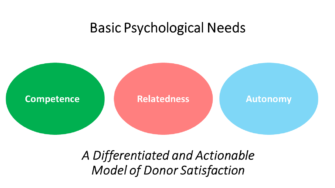Is Your Donor Angry or Dissatisfied?
Is your donor angry or dissatisfied?
Hopefully donor dissatisfaction and anger are rare in your organization though first year retention rates make a pretty strong argument for dissatisfaction being a major concern.
Service failures can take many forms – e.g. name spelled wrong, sending too many solicitations, leading donors to wonder if their donation was wasted – as can donors’ reaction to these sorts of service failures.
Recent research in the customer domain found that dissatisfaction and anger are very different and lead to very different customer/donor actions. In brief, this is what distinguishes the two:
| Experience | Anger | Dissatisfaction |
| Feelings | Overwhelmed by emotion, like going to explode | Unfilled |
| Thoughts | Think what missed out on | Think what missed out on (but with less intensity/duration) |
| Action Tendencies | Feel like behaving aggressively | (no strong action tendencies) |
| Actions | Say something nasty | Make deliberate judgement on how to act |
Dissatisfaction signals the outcome was not as good as expected while anger signals something unfair happened and that preventing it was under the control of the company (charity). In short, these are qualitatively different emotions.
The real learning however is that these emotions have differential impact on the key, negative outcomes of
- switching (“lapsing” in donor world)
- complaining (to the company/charity)
- and telling others (e.g. friends/family) about the bad experience (i.e. negative word of mouth).
The most insightful finding is that dissatisfaction does not directly impact #2 and #3 and has only a partial, direct impact on switching. The linkage between dissatisfaction and complaining is entirely mediated by being angry or not.
Said differently, If I’m angry, I’ll complain to your organization and to others. If I’m not angry, even if I am dissatisfied, I won’t complain. But, if I’m dissatisfied I may switch (quit) and that is even more likely if I’m also angry.
Are you measuring donor emotions? Are you training and empowering donor service representatives to detect anger and move heaven and earth to mitigate it in the moment?
If you are measuring satisfaction and in the simplest of ways (i.e. using the satisfaction term as the survey measure), stop. It provides very little value and is all but useless in predicting certain, key outcomes.
DonorVoice, for example, has gotten much more refined and now measures psychological need states tied to the interaction so we can detect differing types of dissatisfaction parsed into specific failings of creating a sense of autonomy, relatedness or competence (or some combination).
Over forty years of research and theory shows people have three basic psychological needs and satisfying these promotes optimal qualities of motivation and feelings of wellness. These needs are,
- Competence – feelings of effectiveness. For donors, it could mean feeling like they’re making a positive difference. It could also mean learning something new, for example, the problem your charity is trying to solve.
- Relatedness – feelings of being connected and having a sense of belonging with others. Giving and contributing to others is one way people to satisfy their need for relatedness. But how much relatedness donors will actually experience depends on how well your campaigns can foster a meaningful sense of connection between them and both the people receiving their support and your charity. Touchpoints that are plainly role-bound, transactional, and empty of interpersonal salience are not likely to promote a sense of relatedness.
- Autonomy – feelings of willingness and volition. For donors, this first and foremost means not feeling guilted or otherwise pressured or into giving. Providing a convincing rationale, along with meaningful options for choosing how to give support are ways to increase donor autonomy satisfaction.
The more donors feel a sense of competence, relatedness, and autonomy when engaging with your organization, the more likely they will be to commit to your charity for the long-term.
We’ve started measuring feelings of competence, autonomy, and relatedness and have found it gives a much more nuanced, prescriptive set of insights than the typical “satisfaction” measures.

By assessing the need satisfactions that foster optimal qualities of motivation we’re able to better understand the donor experience and let you know what you’re doing well and where you stand to improve.
For example:
- Donors feeling ineffectual or hopeless in promoting a human rights outcome (low competence) after a telemarketing or canvassing interaction (and despite saying “yes” to the ask) means these specific donors need enhanced feedback about how their gifts are making a positive difference. But send that enhanced feedback to those with high competence and you risk violating the “show me you know me” maxim of good donor communication.
- Donors feeling unduly pressured or guilted into giving by a pushy canvasser (low autonomy) means those donors (and only those) would benefit from a non-pressurized, “save call” designed to provide more rationale for your charity and their choice.
- Donors feeling unappreciated and taken for granted (low relatedness) warrants an apology to mitigate the negative interaction but only for whose relatedness needs were thwarted.
Zero-party data is the only data that can tell a fundraiser what its donors are thinking, feeling, and doing. But, for fundraisers to act they need to reliably know why donors think, feel, and behave as they do. Finding quantifiable and actionable “why answers” starts with asking the right questions and measuring the right constructs.
Kevin


